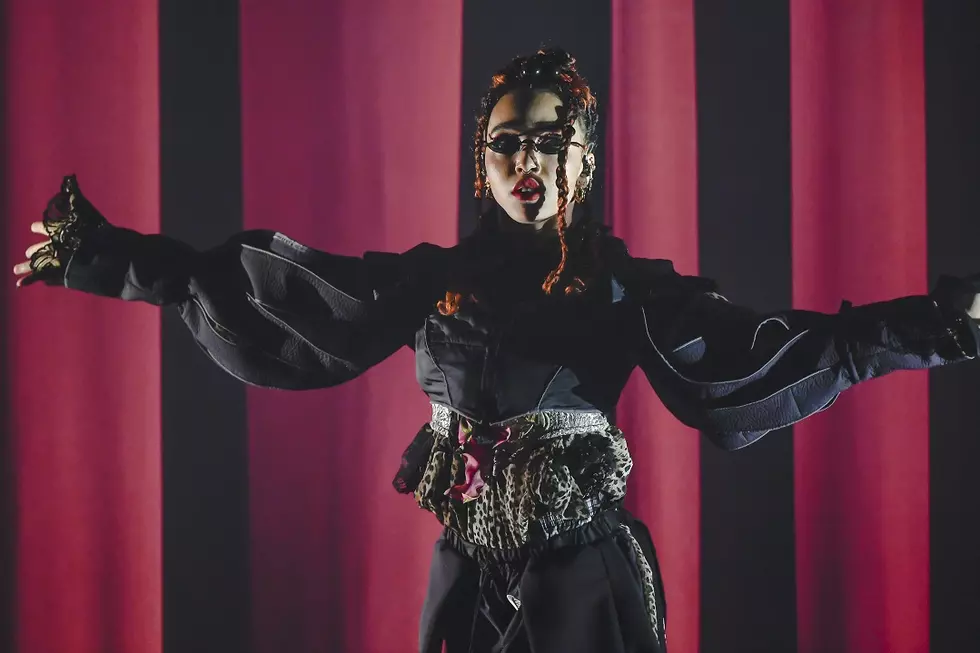
‘Feud: Bette and Joan': Ryan Murphy Finds Tender Middle Ground in a Bitter Rivalry
Female feuds are nothing new in Hollywood, though some more iconic than others.
For every minor celebrity feud, a la Hilary Duff vs. Lindsay Lohan, there’s a woman-on-woman battle that scorches a fire across pop culture and the entertainment industry alike, not unlike the infamous Angelina vs. Jennifer scandal of 2005. But before the Team Jen or Team Angelina tees, there was one feud that Hollywood still talks about.
The tale of Bette Davis and Joan Crawford, played by Susan Sarandon and Jessica Lange respectively, is expertly brought to life in Ryan Murphy’s Feud, a recreation of Hollywood’s most iconic feud based around the film What Ever Happened to Baby Jane? The feud's from the '60s, but the issues from the yesteryear of Hollywood still echo in the industry today. Bette and Joan were huge stars in their heyday, but time's gone on, skin has started to sag and phones have stopped ringing. The struggle of ageism in Hollywood, more specifically ageism against women, is explored expertly by both Sarandon and Lange, with Sarandon out-sassing Lange at every chance imaginable, and Lange bringing Joan’s desperation for respect and fame to life with every quiver in her voice.
Rare is there a shot in Feud of either Sarandon or Lange not diving into some form of beauty ritual; be it ritualistically rubbing elbows in lemons, slathering a face with layers and layers of Vaseline, or Joan’s insane practice of smothering her face in a sink full of witch hazel, all aiming to turn back the hands of time even by a minute. In a male dominated industry, let alone a male dominated society, a woman in Hollywood could only be one of three things: an ingénue, a mother, or a gorgon. Both actresses face a fight against time and thus, fight each other for one more curtain call in front of the public.
The strength of the show comes from its balance of the grand and the subtle. Ryan Murphy is known for being a little extra, but Feud might just be his most muted piece yet.
There are no monsters popping out from around the corner ready to attack, there are no show-stopping choir numbers, and there’s no white Bronco or banging gavels. Rather all there is Joan and Bette, front and center, under their respective spotlights. The slow burn is what also provides the greatest element of suspense and intrigue: closer to Murphy’s American Crime Story, the suspense lies in an outcome we already know. What transpired between Joan and Bette during the 1960s is easy to find with a quick Google search, but watching the two spar under the guise of photo ops, joint interviews, and crooked smiles is a pleasure unto itself.
Feud does still carry the weight of a Murphy production — his love affair with Old Hollywood and the glamour and the grandiose lifestyle is apparent from the start — but it’s his delicate hand when approaching the humanness of Bette and Joan, rather than the celebrity, that is the trademark of the show. He sees them not as characters, like how the misogynistic film industry saw them, but as women. It’s no surprise Feud is a female driven show, driven home by the fact Catherine Zeta-Jones and Kathy Bates, celebrities in their own right, play supporting characters, but a show about women in Hollywood and the lengths they must go to stay in control of their own life.
Throughout the pilot, the similarities between the two are glaring: both are older than the Hollywood median, both are celebrated actresses with various epithets and accolades, and both have been wronged by men and the industry ran by them. Rather than being friends, their similarities are used as a means of weaponry against their envy of youth and the power it wields. There is a nagging feeling in every civil scene between the two that begs the question of whether Bette and Joan could have been friends if they just sat down and had a talk, woman to woman, but anyone familiar with the history between the two movie stars, knows this would never come to be.
Feud is a tour de force for Lange and Sarandon, both of whom will no doubt receive award nominations when the time comes; a fitting testament to the legacy and relevancy of Joan Crawford and Bette Davis. With a supporting cast that also includes Stanley Tucci and Alfred Molina, it’s a nonstop study into the idea of what it means to be a female celebrity before the age of TMZ and Twitter, and how the world is often too cruel to actresses who are just human at heart. It borrows elements from all of Murphy’s shows — the heightened real world horrors from American Crime Story, the sensationalism and spectacle of Glee, and the suspense and drama of American Horror Story — and blends it all together into a vehicle for Murphy to comment on ageism, sexism, and stardom, against the illuminating backstory of two of Hollywood’s legendary actresses and the infamy they left behind.
Fifty Shades of Celebrity Feuds:
More From Mix 97.9 FM









